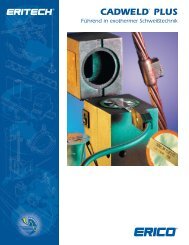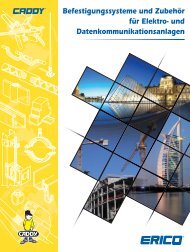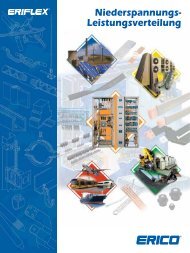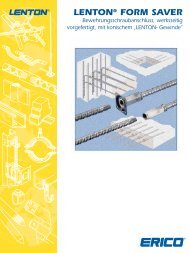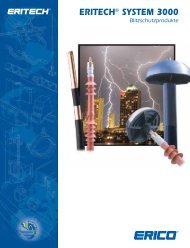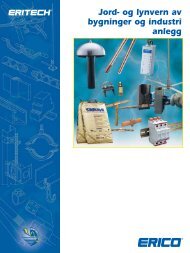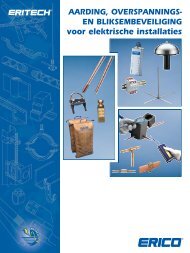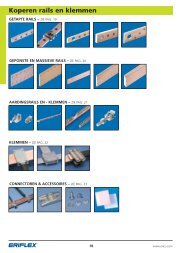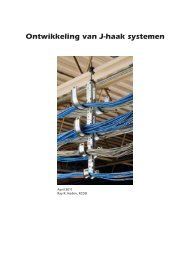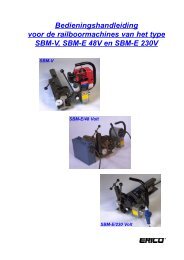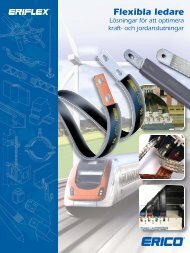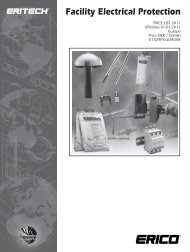Coordinated Facility Protection Catalog - Erico
Coordinated Facility Protection Catalog - Erico
Coordinated Facility Protection Catalog - Erico
You also want an ePaper? Increase the reach of your titles
YUMPU automatically turns print PDFs into web optimized ePapers that Google loves.
Selecting Surge <strong>Protection</strong><br />
Recommended Surge Ratings –<br />
A Comparison between IEC and IEEE ®<br />
Recommendations<br />
Competition between SPD manufacturers has seen everincreasing<br />
surge ratings being offered to the market, to the<br />
point where surges of this magnitude are unlikely to ever occur<br />
in nature. A number of sources provide information on the<br />
statistical distribution of the current discharge of the direct<br />
lightning strike. Many studies have shown that peak lightning<br />
discharges above 100kA are likely to occur less than 5% of<br />
the time. Combined with the fact that most discharges do not<br />
strike the power line directly but are magnetically or capacitively<br />
coupled to it, and that even under a direct lightning discharge<br />
the energy will split in either direction and be attenuated by<br />
the distribution arresters and line losses, it is not diffi cult to<br />
determine that a smaller fraction of the initial lightning energy<br />
typically enters the facility in question.<br />
ANSI ® /IEEE standard C62.41 has classifi ed the “point-of-entry”<br />
environment as CAT. B/C. Under this classifi cation the highest<br />
expected energy level is 10kA 8/20μs. In contrast, the IEC61312<br />
and DIN VDE 0675 defi nes some differing guidelines. IEC<br />
61000-5-6 and IEC 61312-1 describe protection zone concepts.<br />
This is similar in nature to the ANSI/IEEE C62.41 concept of<br />
Category A, B & C locations.<br />
A “Zone” is where the lightning electromagnetic environment<br />
can be defi ned/controlled. The zones are characterized by<br />
signifi cant changes of electromagnetic conditions at these<br />
boundaries. These will typically be building boundaries, or the<br />
point where protection is installed.<br />
LPZ OA Zone subject to direct strikes<br />
LPZ OB Zone not subjected to direct strikes, but unattenuated<br />
electromagnetic fi elds may occur.<br />
LPZ 1 Zone not subjected to direct strikes and where<br />
currents in this zone are reduced compared to<br />
Zone OB<br />
LPZ 2... If further reductions in current from LPZ 1 are<br />
achieved/required further zones can be created.<br />
Actual surge ratings required in each of these zones is not<br />
exactly defi ned and is largely determined by some sitespecifi<br />
c details. However, to assist with this the VDE0675<br />
Part 6 standard defi nes the minimum class of product that<br />
can be applied to each of these Zones as shown below:<br />
Class A : Arrester for use in low-voltage overhead lines<br />
Class B : Arrester for lightning current equipotential<br />
bonding (must withstand 100kA 8/20μs or<br />
10As charge, twice). Zones OB to 1 (Main<br />
distribution Boards, Sub-Boards)<br />
Class C : Arrester for over-voltage protection (must have<br />
a nominal surge rating of at least 5kA 8/20μs)<br />
Zones 1 to 2 (mainly sub-boards or low exposure<br />
main boards)<br />
Class D : Arrester for portable use on socket-outlets<br />
(must have a nominal surge rating of at least<br />
1.5kA 8/20μs)<br />
www.erico.com 7<br />
LPZ 0A<br />
<strong>Protection</strong> zones defi ned by specifi c product application.<br />
As it can be shown, protection equipment<br />
for power supply systems are classifi ed<br />
as follows, according to its task<br />
Lightning current equipotential bonding arresters must be<br />
capable of conducting a portion of the lightning current without<br />
being destroyed. Over-voltage arresters are only used for limiting<br />
over-voltages at relatively smaller surge currents. The different<br />
“protection zones” assume the division of the initial lightning<br />
current, from zone 0 to higher zones. For zone 0, it is required for<br />
the user to select the lightning protection class, from I - IV : (i.e.<br />
these refer to maximum energy within a direct lightning strike).<br />
<strong>Protection</strong> Level<br />
Level I<br />
Level II<br />
Level III - IV<br />
LPZ 0B<br />
Lightning terminal<br />
collection volume<br />
Shielded<br />
Room<br />
LPZ 2<br />
Current Magnitude<br />
200kA (10/350μs)<br />
150kA (10/350μs)<br />
100kA (10/350μs)<br />
LPZ 1<br />
LPZ 0A<br />
• Lightning Current Arrester<br />
• Over-voltage Arrester<br />
% Exceeded<br />
~ 0.2%<br />
~ 1.5%<br />
~ 3%<br />
The above levels can be selected based on the statistical level of<br />
protection required. A lightning current of 200kA (10/350μs) can be<br />
expected for the <strong>Protection</strong> Level I. This lightning current is divided<br />
as follows in the most exposed sites:<br />
50% (100kA, 10/350μs) discharges via the ground system.<br />
50% (100kA, 10/350μs) fl ows into the supply systems connected to it,<br />
via the three phase equipotential bonding lightning arresters.<br />
On the other hand IEEE has adopted a Scenario II event, in which the<br />
building lightning protection system is subjected to a direct strike<br />
and the energy level sustained by the equipotential bonding surge<br />
arrester(s) is taken to be 10kA (10/350μs) or approximately 100kA<br />
8/20μs as a worst case.<br />
If we adopt IEC or DIN VDE Standard and assume a level of III-IV<br />
lightning protection system, each equipotential bonding surge<br />
arrester connected to a three phase, four wire, power system is<br />
assumed to experience a 12.5 kA (10/350μs) energy level at the<br />
Zone 0 interface due to lightning current sharing.



